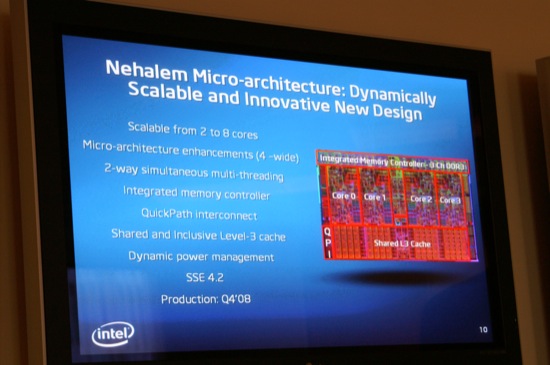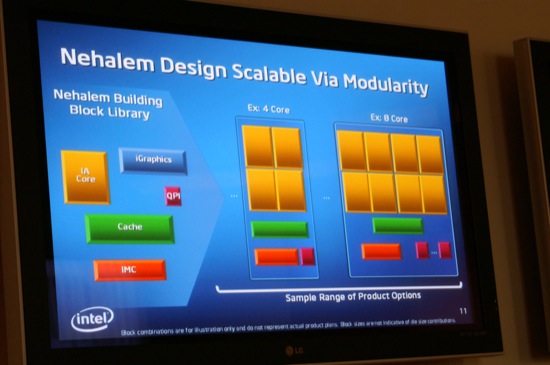Opening the Kimono: Intel Details Nehalem and Tempts with Larrabee
by Anand Lal Shimpi on March 17, 2008 5:00 PM EST- Posted in
- CPUs
Nehalem supports QPI and features an integrated memory controller, as well as a large, shared, inclusive L3 cache.
Nehalem is a modular architecture, allowing Intel to ship configurations with 2 - 8 cores, some may have integrated graphics and with various memory controller configurations.
Nehalem allows for 33% more micro-ops in flight compared to Penryn (128 micro-ops vs. 96 in Penryn), this increase was achieved by simply increasing the size of the re-order window and other such buffers throughout the pipeline.
With more micro-ops in flight, Nehalem can extract greater instruction level parallelism (ILP) as well as support an increase in micro-ops thanks to each core now handling micro-ops from two threads at once.
Despite the increase in ability to support more micro-ops in flight, there have been no significant changes to the decoder or front end of Nehalem. Nehalem is still fundamentally the same 4-issue design we saw introduced with the first Core 2 microprocessors. The next time we'll see a re-evaluation of this front end will most likely be 2 years from now with the 32nm "tock" processor, codenamed Sandy Bridge.
Nehalem also improved unaligned cache access performance. In SSE there are two types of instructions: one if your data is aligned to a 16-byte cache boundary, and one if your data is unaligned. In current Core 2 based processors, the aligned instructions could execute faster than the unaligned instructions. Every now and then a compiler would produce code that used an unaligned instruction on data that was aligned with a cache boundary, resulting in a performance penalty. Nehalem fixes this case (through some circuit tricks) where unaligned instructions running on aligned data are now fast.
In many applications (e.g. video encoding) you're walking through bytes of data through a stream. If you happen to cross a cache line boundary (64-byte lines) and an instruction needs data from both sides of that boundary you encounter a latency penalty for the unaligned cache access. Nehalem significantly reduces this latency penalty, so algorithms for things like motion estimation will be sped up significantly (hence the improvement in video encode performance).
Nehalem also introduces a second level branch predictor per core. This new branch predictor augments the normal one that sits in the processor pipeline and aids it much like a L2 cache works with a L1 cache. The second level predictor has a much larger set of history data it can use to predict branches, but since its branch history table is much larger, this predictor is much slower. The first level predictor works as it always has, predicting branches as best as it can, but simultaneously the new second level predictor will also be evaluating branches. There may be cases where the first level predictor makes a prediction based on the type of branch but doesn't really have the historical data to make a highly accurate prediction, but the second level predictor can. Since it (the 2nd level predictor) has a larger history window to predict from, it has higher accuracy and can, on the fly, help catch mispredicts and correct them before a significant penalty is incurred.
The renamed return stack buffer is also a very important enhancement to Nehalem. Mispredicts in the pipeline can result in incorrect data being populated into Penryn's return stack (a data structure that keeps track of where in memory the CPU should begin executing after working on a function). A return stack with renaming support prevents corruption in the stack, so as long as the calls/returns are properly paired you'll always get the right data out of Nehalem's stack even in the event of a mispredict.













53 Comments
View All Comments
dreddly - Wednesday, March 19, 2008 - link
Your stubborn refusal to acknowledge the repeated objections to the insertion of a sexually inappropriate innuendo into the headline does not constitute 'vague mutterings'.If this site persistently juxtaposed sexually charged images of women with their headlines (akin to maxim) to make a literary statements or metaphors, then it would not be an issue. The objection is to complete irrelevance and seeming ignorant refusal to justify why the image of a Japanese women was chosen and why a traditionally conservative and respectful piece of clothing -the kimono- became the focal point for 'exposure'.
The point you have consistently ignored is that if we replace the image of the Japanese women with a man or a image of a woman on the beach, the non-nonsensical nature of the headline is overly and absurdly apparent.
Your persistent attempts to imply that this argument is anti-sex is as laughable as your understanding of contemporary feminism. If anandtech has decided to go the maxim route, fine, there is an range of arguments and a justifiable reasons to counterpose technology and sex. The problem is that there is no justification or purpose for the headline - it isn't very literary and doesn't relate to the overall purpose of the site. As such, it is a superficial and unnecessary trope, the use of which DOES replicate and connotate a persistent stereotype of sexualized asian women. The use of the stereotype out of ironic or literary context appears to be DESIGNED to offend women and asians who object to those oversimplications that have often used to discriminate and marginalize in the past.
Screammit - Sunday, March 23, 2008 - link
"The use of the stereotype out of ironic or literary context appears to be DESIGNED to offend women and asians..."I'm totally with you on this Anandtech marginalization conspiracy theory, but i'm pretty sure the girl in the picture did something to deserve it. I was kinda hoping for the new Nehalem chips to be used as pasties, but hey, there's always the next article, right?
hobel - Tuesday, March 18, 2008 - link
You are the only who thinks that a kimono is womans clothing only.In the context with the image, ok... but the headline only is gender neutral. Or never seen a sumo ringer in kimono?
jasongg06 - Tuesday, March 18, 2008 - link
Well put. This title is inappropriate. Not only is it offensive to women, it is also offensive to Asians in general. You'd think in 2008 people would have better taste and judgment.masher2 - Tuesday, March 18, 2008 - link
> "it is also offensive to Asians in general..."The headline implies:
a) That somewhere in the world, some women still wear kimonos, at least under some circumstances.
b) That at least some men still remain sexually attracted to women.
Which of these suggestions is "offensive to Asians in general"?
ocyl - Tuesday, March 18, 2008 - link
Agreed. I don't think that the article title and the front-page image are appropriate, either, considering that there is no need to sensitize / emotionalize the subject matter.madoka - Tuesday, March 18, 2008 - link
Yes, the title and imagery is pretty crass and tasteless.masher2 - Monday, March 17, 2008 - link
I commend you on your ability to be offended by pointless trivia.Griswold - Tuesday, March 18, 2008 - link
Good thing you're not the authority on what is "pointless trivia" and what is not.Tilmitt - Monday, March 17, 2008 - link
As someone with a Japanese girlfriend...I loved the title!